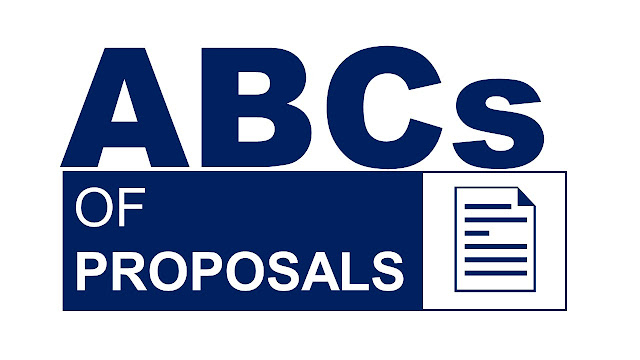The ABCs of Proposals: Part 2
This article started as a joke between a good friend of mine
and me. This friend—who is also in the proposal industry—recently had a baby.
At first we joked that the poor child would fall asleep to her mama reading
RFPs aloud to her. Then we thought, how cute would it be if we made an ABC Book
for our future little proposal manager? And that turned into, well wouldn’t
that just be a unique and fun format for a proposal blog?
So here it is, in its final form, Part 2 of 3: The ABCs of Proposals. If you missed the
first article, you can read it here: https://www.proposalreflections.com/2019/04/the-abcs-of-proposals-part-1.html.
J is for Joint
Venture (JV)
A JV is a business entity created by two or more parties,
generally characterized by shared ownership, shared returns and risks, and
shared governance. JVs can be a useful alternative to subcontract agreements in
certain situations; for example, to leverage a teammate’s past performance
where subcontractor past performance is not allowable.
K is for Key
Personnel
When personnel qualifications are a high evaluation factor,
it becomes even more critical choose the best, most highly qualified personnel
for the project. Ideally, the Capture Team will select key personnel well in
advance of the RFP release. The Capture Team and Resume Lead typically work
together to develop criteria for selecting personnel based on the evaluation
factors provided in the RFP and any other information known regarding the
customer’s preferences.
L is for Low Price
Technically Acceptable (LPTA)
LPTA procurements are intended to be used when “the
requirement is clearly definable and the risk of unsuccessful contract
performance is minimal.” LPTA is best suited for product deliveries. The award
goes to the lowest priced offeror who submitted a technically acceptable
proposal. LPTA procurements are generally evaluated in one of two ways. One
approach is to determine the technical acceptability of all proposals and then
identify which of these proposals offered the lowest price. Alternatively, the
agency can determine which offeror has the lowest price first and then
determine if that offeror also submitted a technically acceptable proposal.
M is for Management
Volume
The management proposal must demonstrate that the offeror
can manage the contract on time, on schedule, within cost, and in accordance
with the contract requirements. The management approach should outline the
overall management concepts used by the offeror and the specific type of
management that will be employed on the contract. The proposed management
approach must reflect the customer’s way of doing business, as well as the
company's. This includes organizational elements, management systems, and
documentation formats. Additionally, the management approach should demonstrate
the flexibility to respond quickly and effectively to changes throughout the
project lifecycle.
N is for Noncompliant
First and foremost, your response must be compliant. You
should structure your response to the Proposal Instructions (typically Section
L) and the Evaluation Criteria (typically Section M). Next map to other
requirements, as required. For example, in technical sections, it may be
necessary to map to certain Statement of Work (SOW) areas (typically Section
C). To facilitate evaluation, consider including relevant RFP references in
your section heading titles. Additionally, evaluators often do key word
searches to find what’s important to them. Make sure all sections include key
words from the instructions, evaluation criteria, and the SOW.
O is for Oral
Presentation
The oral proposal is a method of evaluating offers for
competitive procurements. The Government uses the oral proposal process to test
the offerors’ understanding of the work and their capability to perform. Orals
may be required in addition to a written proposal, or they can be required
instead of a written proposal. Through the oral presentation, the evaluators
can observe how well the presenters—typically the key personnel—work together
as a cohesive team. During the presentation, evaluators will take stock of (whether
consciously or unconsciously): cohesion, chemistry, professionalism, knowledge,
integrity, and poise.
P is for Past
Performance
The Government is interested in an offeror’s history of
performance in terms of quality of product/service, cost control, timeliness of
performance, business relations, and customer satisfaction. Agencies may validate
performance through Contractor Performance Assessment Reports (CPARs) and/or
evaluation questionnaires. To score high on past performance: 1) select
references that will yield the highest marks on evaluation CPARs and
questionnaires completed by your customers, and 2) create an effective
presentation of past performance in the proposal.
Q is for Question and
Answers (Q&A)
During the Final RFP phase, it's so important to take full
advantage of the Q&A sessions. The core proposal team and impacted company
stakeholders should thoroughly read the RFP with an eye for their individual
expertise. For example, the Contracts Manager should review for areas of
contractual concern, the Security Manager should review for any security
implications, and Technical SMEs should review for items that may impact the
technical solution. Make sure to ask questions where clarification is
necessary. To help the Government keep their schedule, start gathering
questions early, and submit the questions by the questions deadline.
Final Words and Part
3 Preview
Even though this started out as a joke between friends, this
has definitely turned into a fun little article series jam packed with some
useful tips and advice for proposal professionals. Next week we will cover R –
Z. Can you guess which topics might be included?
Written by Ashley (Kayes) Floro, CPP APMP
Senior Consultant and PresidentProptimal Solutions, LLC
proptimalsolutions.com





Comments
Post a Comment